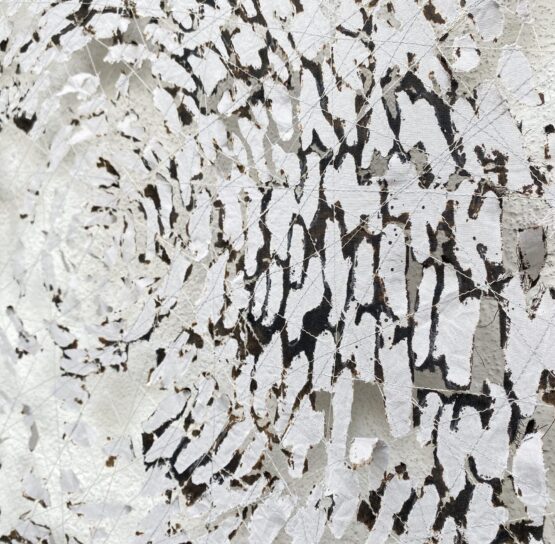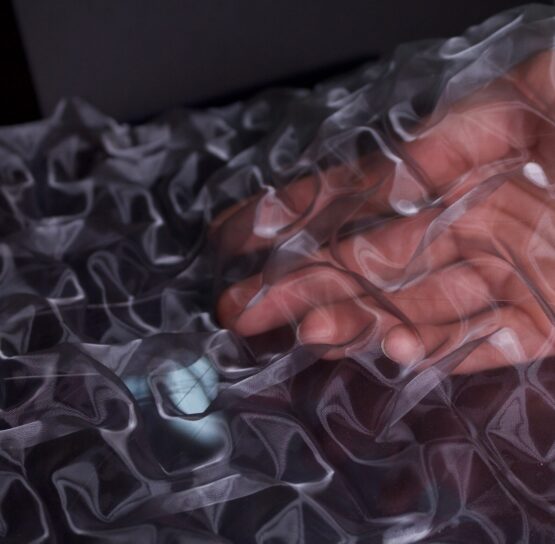Isha Pimpalkhare
Blending biophilic design with motion, Munich-based artist Isha Pimpalkhare humanises material surfaces through kinetic textiles and speculative installations that echo the rhythms of life.
Munich-based mixed-media artist Isha Pimpalkhare’s work combines art and design to evoke a sense of ‘biophilia’ —the idea that humans are naturally drawn to connect with other living things, like animals, plants, and nature. Through kinetic sculptures, installations, and speculative design, she brings motion to textile surfaces and encourages viewers to engage and connect with the material form. Trained in Textile Design at NID and holding a Master’s in Mixed Media Textiles from the Royal College of Art, London, what sets Isha’s works apart is the way she humanises surfaces— through ripples and shadows, they tap into the human tendency to empathise with even non-living things. This affinity for ‘hands-on making’ can also be traced back to her formative years, prior to higher education, when she spent time immersed in origami, pottery and painting in studios. Some of Isha Pimpalkhare’s recent installations, such as Alive, Aflow, exhibited under prominent platforms like Tao Art Gallery and India Art Fair, use static forms to evoke a striking sense of movement. In these, fragments of textiles are delicately woven into web-like frames that visually mimic the flow of water or the undulation of waves. Her earlier and ongoing explorations include 3d sculptures—ranging from paper origami to textile compositions—that use technology to simulate the rhythms of life, such as breath and movement. Installations like Alive 1.0, Alive 2.0, and Timeless carry a quiet, futuristic energy, where delicate fabrics swell and contract gently, evoking a sense of calm and sentient presence. Isha’s creative process doesn’t start with sketches or planning on paper—instead, her thoughts take shape directly through the materials she works with. Alongside her independent practice, Isha has worked across a diverse spectrum of industries—including fashion, products and automobile design. She is currently part of Designworks, the design innovation studio of the BMW Group, where she oversees selecting and integrating colors, materials, and surface finishes to enhance a product's visual appeal, tactile experience, and alignment with brand identity.



Isha speaks to Blur The Border :
Blur : From NID, India to the Royal College of Art, London and now BMW Designworks in Germany— your journey has given you insights into different cultures. How has your understanding of textiles evolved across these different institutions and industries?
Isha : NID and RCA have definitely been very defining times for me, as for many during their education, where one has the chance to immerse themselves fully into the subject, absorbing all the stimuli from all around. NID laid a very strong foundation for design and textiles for me, giving me a sound technical understanding of textiles as a material and a medium of expression. RCA was a masters course, and helped me look a lot more inwards - to find a voice to my practice - about what the medium meant to me. I always find myself to be standing at the convergence of art and design, while being drawn to the idea of how our material culture plays such a huge role in our everyday life and design; and also finding a sense of self expression onto a tactile medium. Working at BMW AG and BMW Designworks, in the capacity of a CMF Designer, has been a very interesting balance of working very closely with the market, trends and customer needs, at the helm of the latest design and technology.
Blur : Your work mimics breathing and movement, almost like giving textiles a ‘human’ quality. What inspired you to look at textiles, as a medium, have a unique ability to capture organic, life-like qualities?
Isha : We are constantly surrounded by materials of all kinds. What used to be the savannahs, is now concrete, wood, textiles, plastics, metal, etc. Living in natural surroundings, as our ancestors did, helped have a very seamless and responsive information exchange with our environment. There was a deeper emotional and spiritual connect which we had with nature, which we don’t have anymore in the concrete jungles we live in. This investigation of a more meaningful exchange with our environment led me to experiment with kinetic textiles and bring life like qualities onto the surface.
Blur : If you could give textiles one more ‘human’ characteristic, what would it be and why?
Isha : ‘Responsiveness’ would be a characteristic which I would love to further explore in my practice. Textiles responding to outer stimuli which could be from humans or the environment itself, thus creating a dialogue between the two.
Blur : How has your artistic style evolved over the years, and how do you view this evolution?
Isha : To be honest, it’s not been many years to my artistic career, so I wouldn’t say there is a large evolution to my practice. I definitely feel I am drawn to work on larger canvases than before. At the moment I also find the frame around my art piece to be restrictive, and find the need to break out of the frame format, and create works which are more three dimensional.
Blur : Do you have a definitive process while creating? Are there any habits or rituals that help you get into a creative mindset?
Isha : A large part of my process of actually creating the work is quite instinctive. I always like to be reading something relevant to what I am thinking about, while I am working on a new concept or a series of works. It helps me develop my thoughts and sketches, and add more weight to my ideas. As far as habits go, especially if I am starting work on a new piece, I like to start first thing in the morning, and not have any distractions around, calls/meetings or any other chores to interrupt my flow. Freeing up my mind is quite important for me while creating.
Blur : What role does the environment play in your work or in fueling your creativity?
Isha : Of course the environment definitely plays a large role - whether it’s the studio space you work out of, or the outdoor spaces you visit. For me personally, having a defined workspace is quite important to even maintaining a train of thought and flow to my work. And again, the kind of environment and spaces one exposes oneself to, outside of working hours, also plays its own role in leaving impressions on your mind which one might take back to their drawing board.
Blur : As technology advances, do you think we’re moving towards more intelligent, responsive fabrics or return to something more primal and hand-crafted?
Isha : In my personal opinion, the need for tactile materials and interactions will never go away. Touch, being a very important part of our sensory experience of the world, can never be replaced by AR/VR. That being said, technology, if used responsibly and meaningfully, can definitely augment and aid our everyday experiences. So a more considered and meaningful use of technology integration would be an ideal approach.
Blur : Are there any other mediums you are looking to explore in the future?
Isha : I am really drawn to idea of making larger sculptural pieces, once that humans can interact with at very different scale - sculptures that people can walk through and experience all around them. I would imagine that would bring in combining architectural elements with textiles, to create such huge immersive environments.
Blur : If you were to collaborate with artists outside of your discipline, what would be that one collaboration you'd love to pursue?
Isha : I would say Neri Oxman would definitely be someone whom I would love to have an exchange and collaboration with! Her work combining nature and technology is absolutely inspiring, to say the least, and it would be a dream to work closely with her!